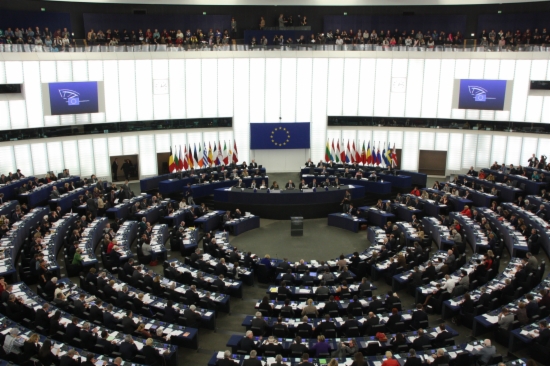European Parliament’s final approval of the Mediterranean Railway Corridor
After years of debate, the new European Union’s Transport Priorities have finally been approved. The European Parliament has approved the Commission’s plan to build 9 major transport corridors connecting the continent from West to East, North to South and in diagonal. The Mediterranean Corridor for freight and passengers is one of these 9 priorities and will link Barcelona and Tarragona to the Gibraltar Straight and Central Europe, connecting major production centres, import/export infrastructures and tourist destinations. The final plan ignores the Spanish Government’s request to include the Centre Pyrenees Corridor as well, a project that was bypassing Catalonia and therefore Barcelona, despite being Spain’s main industrial, export and tourist centre and being geographically attached to France.

Strasbourg (ACN).- After years of debate, the new European Union’s Transport Priorities have finally been approved this Tuesday. The European Parliament has given its definitive green light to the Commission’s plan to build 9 major transport corridors connecting the continent from West to East, North to South and in diagonal. The Mediterranean Corridor for freight and passengers is one of these 9 priorities and will link Barcelona and Tarragona to the Gibraltar Straight and Central Europe, connecting major production centres, import/export infrastructures as well as main tourist and business destinations. This infrastructure will enable freight to travel on international-standard with railway from Germany, Sweden or Hungary to Barcelona or Tarragona and vice-versa. It will also combine high-speed trains for passengers. Barcelona and Tarragona are already linked with high-speed train to France, but the Corridor will also link the Catalan cities to Valencia, Murcia, Seville and Algeciras, in the Gibraltar Bay. It will transform Barcelona and Tarragona into strategic gateways, linking Europe to Northern Africa and Asia. The port of Barcelona has already been linked to Central Europe through international-standard width for a year, but through a provisional solution that should be properly addressed with the Mediterranean Corridor. The EU Transport Priorities for the 2014-2020 period have been approved in the Parliament’s plenary session in Strasbourg with 546 votes in favour, 104 against and 41 abstentions. The Catalan Minister for Transport, Santi Vila, welcomed the plan and stated that it ends Spain’s “radial” design of transport infrastructure networks (which was totally prioritising connections with Madrid).
The Spanish Government’s plan to bypass Catalonia has been ruled out by the EU
The EU final plan ignores the Spanish Government’s request to include the Central Pyrenees Corridor as well, a project that was bypassing Catalonia and therefore Barcelona, despite being Spain’s main industrial, export and tourist centre and being geographically attached to France. However, the definitive plan also includes the Altantic Corridor, linking Lisbon, Madrid, Bilbao, Bordeaux and Paris. The EU will fund up to 40% of the Mediterranean and Atlantic Corridors’ construction cost and the rest will come from public and private funds.
A network connecting 94 main European ports
The EU has approved its new Transport Priorities for the next 7 years, which represent a major policy change, as stated by the European Commission. The EU plan prioritises 9 major corridors: 2 North–South corridors, 3 East–West corridors; and 4 diagonal corridors. They will connect 94 main European ports with rail and road links and 38 key airports with rail connections into major cities. In addition, 15,000 km of railway line will be upgraded to high speed and 35 cross-border projects will be developed to reduce bottlenecks.
EU funds will cover 40% of the cost
It will be funded through the ‘Connecting Europe Facility’ (CEF), a €29.3 billion programme, €23.2 billion of which will be allocated to improving transport connections, €5.12 billion to upgrading energy networks and the remaining €1 billion to telecommunications. The new priority projects should be finished by 2030 in order to receive EU funds covering 40% of the overall expenses.
Catalonia, a strategic part of the Mediterranean Corridor
The Mediterranean Railway Corridor will combine freight and passenger transportation through international-standard width railway and high-speed trains. It will connect the Catalan cities of Barcelona, Tarragona, Girona, Figueres, Reus and Tortosa with Gibraltar and Central and Northern Europe. In addition, it will connect the ports of Barcelona, Tarragona, València, Algeciras and Cartagena. The project also includes a stretch linking Madrid to Algeciras and Madrid to Zaragoza and then Barcelona, as otherwise Madrid would have not been included in the Mediterranean Corridor and would only have been part of the Atlantic one.
A “genuinely European” network
In the presentation of the new EU Transport Priorities for 2014-2020, the European Commission Vice-President Siim Kallas, who is responsible for Transport, said: “Transport is vital to the European economy. Without good connections Europe will not grow or prosper. This new EU infrastructure policy will put in place a powerful European transport network across 28 Member States to promote growth and competitiveness. It will connect East with West and replace today’s transport patchwork with a network that is genuinely European.”